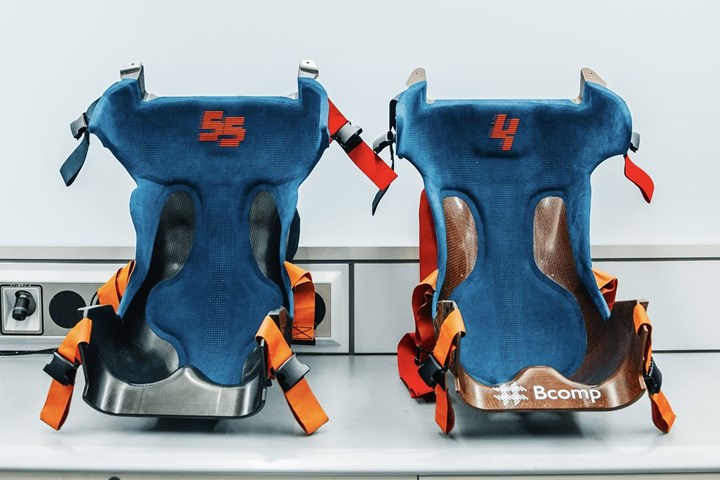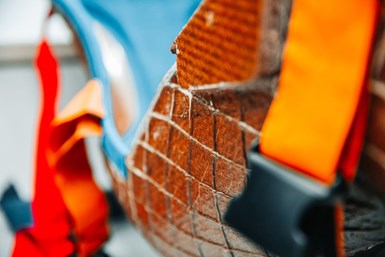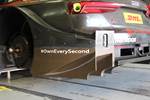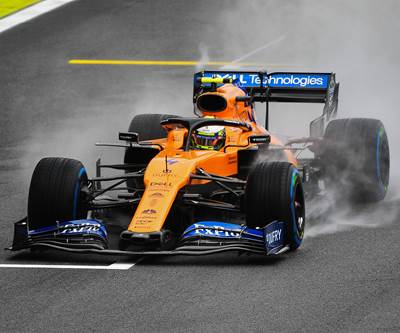McLaren, Bcomp use natural composite fibers in F1 racing seat
The flax fibers meet strength and stiffness requirements while reducing vibration, cost, enhancing safety and lowering its CO2 footprint by 75%.

Source | McLaren
According to U.K.-based McLaren, a recent pioneering breakthrough that may further transform motorsports and beyond, is a natural fiber racing seat, considered to be the very first Formula One (F1) car part to be made of renewable textile fibers.
Collaborating with sustainable lightweight manufacturer Bcomp (Fribourg, Switzerland), the novel racing seat being made for Carlos Sainz and Lando Norris is said to optimize the mechanical properties of flax fibers through fabric architecture, developing a seat with the required strength and stiffness, but with a 75% lower CO2 footprint compared to its carbon fiber counterpart. Similarly, compared to the introduction of the first car with a carbon fiber monocoque chassis — the McLaren MP4/1 Formula One (F1) racing car in 1981, which is said to have heavily influenced racing car design to this very day — the flax fibers are considerably cheaper, reduce vibration, enhance safety and are a more sustainable alternative.
“The use of natural fiber composites is the latest example of pioneering, composite materials innovation at McLaren,” explains McLaren F1 team principal Andreas Seidl. “Not only does this solution provide equivalent performance to carbon fiber, it represents another step forward in our evolving sustainability program, while underlining our commitment to helping F1 turn its ambitious sustainability strategy into action.”
“For decades, F1 has been an innovation lab for technology that has transformed not just motorsport, but the automotive industry and beyond,” adds McLaren F1 technical director James Key. “The sport must continue down the road of developing increasingly environmentally-friendly options, and our development and application of natural fiber composites is an example of how we’re accelerating this journey, as well as the ongoing evolution towards cleaner mobility.”
Primarily used in the production of linen, McLaren notes that flax is an incredibly versatile plant. Further, flax is a CO2-neutral raw material and its fibers are biodegradable. At the end of the seat’s life, for example, it can be ground down into a new base material or thermally recycled without residual waste, rather than ending up in landfill.
With Bcomp’s solutions reducing raw material cost by up to 30% compared to traditional carbon fiber, the significant cost savings could free up budget to explore other ways of improving car performance.
Inspired by the thin veins on the back of leaves, Bcomp’s proprietary powerRibs technology is said to provide a 3D grid structure on one side of the seat, which is then used to reinforce Bcomp’s spun and woven flax fiber reinforcement fabric, ampliTex. Made by twisting flax fibers to form a thick yarn, the powerRibs are said to act as a backbone to the ampliTex flax fabric that is bonded to it.
According to the McLaren F1 team, the original carbon fiber seat design was reverse engineered by Bcomp, and the new design was optimized and manufactured by McLaren. The seat was then run in pre-season testing without any problems.
“Sustainability and decarbonization is a global issue, and it is fantastic to see motorsport embrace carbon alternatives, paving the way for widespread adoption within large-scale mobility applications,” says Bcomp CEO and co-founder Christian Fischer, echoing the McLaren team’s sentiment. “McLaren has always been a pioneer within the sport, in terms of both composites and sustainability. It feels like the perfect match and a great honor to collaborate with such a prestigious brand.”
So just why did McLaren begin with turning natural fibers into a lightweight and sustainable racing seat, as opposed to other parts of the car?
According to the team, they saw a clear opportunity to use the technology in this area of the car based on the current F1 technical regulations. Since 2019, says the McLaren team, a minimum driver weight of 80 kilograms has been mandated. Moreover, if a driver weighs less than that, ballast must be used to bring them up to the minimum weight. But instead of allowing this ballast to be placed in other areas of the car, which could improve weight distribution, it must be located within the immediate area of the driver’s seat.
“With the introduction of the new regulation in 2019, the seat now forms part of the driver’s weight budget, so it’s over-engineered as a result,” explains McLaren F1 principal composites engineer Steve Foster. “And with Carlos and Lando weighing in at 72 kilograms and 68 kilograms respectively, there’s plenty of scope to do that. It meant that, if we needed to, there was margin to use additional bio-composite material to ensure sufficient strength and stiffness in this safety-critical component.”

Source | McLaren
This sufficient strength and stiffness, McLaren adds, is due to the tubular structure of flax fibers, which are said to provide low density and high stiffness, affording the opportunity to reduce weight while simultaneously improving vibration damping, as well as resistance to breakage, torsion and compression. The team adds that flax fibers are considerably more lightweight, being 9% lighter than any equivalent carbon material.
“And when we say ‘significantly better,’ we mean five-times better thanks to Bcomp’s ampliTex flax fabric and powerRibs technology,” says the team. Greater vibration absorption and impact resistance makes the natural fiber material well-suited to use in the driver’s seat. It improves comfort and reduces vibration in the cockpit, which can have a fatiguing effect on drivers, especially over a race distance and particularly at circuits with aggressive kerbs.
The flax fiber’s safety enhancement further make it an improvement in McLaren’s eyes. It is said that when it does break, unlike carbon fiber, it’s not prone to brittle fracture and splintering. “The composite of ampliTex and powerRibs is not as fragile, and while it still breaks, the softer debris remains attached to the main structure with the help of the powerRibs, which help dissipate the energy,” explains Fischer. The ductile fracture behavior is said to show promise in other aspects of F1 racecars as well, including the front wing endplates and the floor, as it could reduce debris and the risk of punctures during on-track collisions.
Further, with a budget cap set that will be introduced by 2021, many F1 teams will need to reduce costs while maintaining and improving performance. Teams are going to have to work even smarter, says the McLaren team, and with Bcomp’s solutions reducing raw material cost by up to 30% compared to traditional carbon fiber, the significant cost savings could free up budget to explore other ways of improving car performance.
“Where we see significant potential is in the non-critical, semi-structural areas of the car, such as the driver’s seat, as well as off the car,” says Fischer. And it’s the latter, reveals Foster, where the immediate scope for further adoption of natural fiber composites really lies: “When used intelligently, the flax fibers reduce weight and cost, while maintaining and, in some cases, even improving performance. There are a range of possible applications beyond the car itself, including pit gear, truck panels, packing cases, timing stands and mold tools.”
With so many potential applications, says the McLaren team, the natural fiber composite racing seat is just the beginning. “This seat is the first step in the successful application of natural fiber composites in F1,” concludes Seidl. “By working with Bcomp we can identify other components that we can replace with a sustainable alternative that has equivalent weight and performance. There is no silver bullet in the race to be carbon neutral. Instead, we must continually evaluate every element of our cars and our operations to identify the ways we can improve performance, drive efficiency and reduce environmental impact.”
Related Content
JEC World 2024 highlights: Glass fiber recycling, biocomposites and more
CW technical editor Hannah Mason discusses trends seen at this year’s JEC World trade show, including sustainability-focused technologies and commitments, the Paris Olympics amongst other topics.
Read MorePUR composite sandwich panels for 3D automotive parts, high-volume panels and more
At its U.S. sites, Ascorium produces glass fiber/PUR 3D parts via semi-automated molding, high-volume flat panels via a continuous line while working toward bio-based PUR and recycling.
Read MoreSuper Resin Inc. highlights plant-based epoxy resin, foam core
Eco-friendly resin system using glycol lignin offers an eco-friendly option for CFRP structures and components, and core materials.
Read MoreOkom wrks labs works with Autodesk for mycelium-based composite commercialization
Research Residency program will further refine material properties and manufacturing processes to support the startup’s efforts of providing high-performance, regenerative biocomposite solutions.
Read MoreRead Next
Volta Trucks incorporates Bcomp’s natural fiber technologies in automotive application
Bcomp’s natural flax fibers and bio-based resin derived from rapeseed oil ensures sustainability, safety and significant weight savings.
Read MoreGerman racing series shifts to natural fiber application
German racing series DTM says the shift away from carbon fibers will be more cost-efficient, improve lightweighting and reduce the organization’s ecological footprint.
Read MoreThe untapped potential in Formula 1 composite manufacture
Formula 1’s midfield teams are struggling to bridge the gap to their better resourced frontrunning counterparts. Could Industry 4.0 composites manufacturing automation level the playing field?
Read More
























